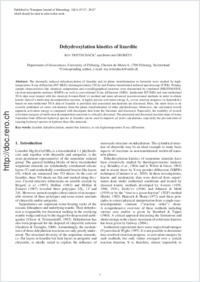Dehydroxylation kinetics of lizardite
- Trittschack, Roy Department of Geosciences, University of Fribourg, Switzerland
- Grobéty, Bernard Department of Geosciences, University of Fribourg, Switzerland
-
01.02.2012
Published in:
- European Journal of Mineralogy. - 2012, vol. 24, no. 1, p. 47-57
English
The thermally induced dehydroxylation of lizardite and its phase transformation to forsterite were studied by high-temperature X-ray diffraction (HT-XRD), thermogravimetry (TGA) and Fourier-transformed infrared spectroscopy (FTIR). Primary sample characteristics like chemical composition and crystallographical structure were determined by combined (HR)TEM-EDX, electron-microprobe analyses (EMPA) as well as conventional X-ray diffraction (XRD). Isothermal HT-XRD and non-isothermal TGA data were treated with the classical Avrami-Erofe'ev method and more advanced isoconversional methods in order to obtain kinetic data of a multi-step decomposition reaction. A highly precise activation energy Ea versus reaction progress (α) dependency based on non-isothermal TGA data of lizardite is provided and associated mechanisms are discussed. Here, the main focus is on recently published ab initio calculations from the phase transformation of other phyllosilicates. Moreover, the calculated overall apparent activation energy is compared with discrepant data from the literature and discussed. Especially, the usability of overall activation energies of multi-step decomposition reactions is critically discussed. The presented and discussed reaction steps of water formation from different hydroxyl species in lizardite can be used to improve ab initio calculations, especially the pre-selection of reacting hydroxyl species in hydrous sheet like minerals.
- Faculty
- Faculté des sciences et de médecine
- Department
- Département de Géosciences
- Language
-
- English
- Classification
- Mineralogy
- License
-
License undefined
- Identifiers
-
- RERO DOC 29031
- DOI 10.1127/0935-1221/2012/0024-2169
- Persistent URL
- https://folia.unifr.ch/unifr/documents/302441
Statistics
Document views: 119
File downloads:
- pdf: 283
